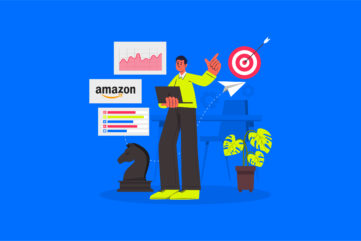What is multi branding? Companies with multiple product lines

A multi branding strategy is the ultimate way to grow your company. Building multiple brands into one entity might seem complex, but it’s a common practice in today’s competitive business world.
As marketplaces change and consumer demands evolve, it’s rare to find an evolving business with a focus on a single line of services or products.
As various manufacturing options become more accessible, consumers grow more demanding, and business consolidation continues, multi branding opportunities are more appealing than ever.
Ultimately, multi branding offers businesses a unique way to diversify their company, reach new customers, and improve revenue streams. Used correctly, it could be a way to turn your organization from a small entity into a huge international corporation.
Today, we answer “what is multi branding” and consider the pros and cons involved in choosing this structure for your brand identity.
What is multi branding? Multi branding definition
Let’s start with the basics: What is multi branding?
Today’s companies have many ways to build and market their organizations. A brand can come in many different forms, from a global venture to a business focused entirely on a specific location.
A company with a multi-branding strategy sells a variety of products and services to a wide, diversified audience under different distinct names or brands.
Look at Coca-Cola. The company doesn’t just sell coke products; it also owns a multitude of other “mini brands,” like Fanta, Sprite, Dasani, and Smart Water.
Some experts define multi branding strategy as a way businesses reach different audiences with specific brand initiatives. An organization may have one brand for general consumers, another for budget-conscious buyers, and another for luxury sales.
Multi-branding also allows organizations to appeal to consumers with specific tastes or preferences by offering various different kinds of products.
There are different ways to set up a multi-brand architecture.
The two most common are:
A branded house
If you’re launching new sub-brands in your organization to serve different needs for the same audience, you’d use a “branded house.” Virgin has Virgin Media, Virgin Atlantic, and Virgin Money to address different requirements.
A house of brands
With a house of brands, companies create various sub-brands to target different audiences. There’s no real connection between the parent brand and sub-brands in this scenario.
Think of P&G; they’re responsible for a huge range of organizations, all with their own distinct branding methods.
Factors in a multi branding strategy
Multi branding is a way to expand the reach and potential of your company by creating specific sub-brands for different purposes. It’s most common among larger companies ready to branch out into new segments and marketplaces.
While there are many factors involved in developing a strong multi brand strategy, the most common components you’ll need to think about include:
Goals or Vision
Each sub-brand in a multi brand strategy should have a specific focus, goal, or vision. In the Virgin multi brand strategy, the purpose of the corporation is to create different companies capable of helping consumers complete various tasks in their lives, from managing money, to exploring the world.
Audience
When creating a multi branding strategy, companies need to think carefully about the specific customer groups they want to reach. The main purpose of a multi-brand is to give you more scope to connect with different customers. You’ll need to decide whether you want to reach specific sub-sections of the same wider audience or completely new groups.
Brand image
Every brand needs a recognizable visual identity. When you create a sub-brand for your multi branding strategy, you’ll need to decide whether the image will be linked to the parent brand or not.
Using elements of an existing brand can improve recognition, but it may not be the right option if you’re appealing to an entirely new audience.
Brand personality
Similarly, every sub-brand you create will need to have a unique personality to connect with your audience. The personality you create for each company will shine through in its image, messaging, and marketing strategies.
You can use elements of your parent brand in your sub-brands or create something new.
Why do companies have multiple brands?
Building a single brand can be a complicated process. There are endless factors involved in bringing your identity to life, from choosing the perfect logo to finding a compelling marketing strategy.
Brands take significant time, work, and investment. You might wonder why any company would want to increase the complexity by adopting multiple brands.
Multi branding strategies aren’t the right option for every company.
In some cases, you can simply release different product lines under the same identity and still reach a wider audience. Coca-Cola has various versions of its coke drink for people looking to watch their weight or those interested in different flavors.
However, multi branding can give you a lot more scope to really build a dedicated target audience for your product line. Sometimes, different items in your portfolio will require a unique branding and marketing approach to resonate with customers.
Look at Toyota.
Toyota sells a huge variety of vehicles under its general brand. While there are multiple automobiles to choose from, including sedans, SUVs, and trucks, they’re all marketed as being affordable, safe, and reliable. This branding strategy works to attract general consumers and drivers.
However, it wouldn’t have the right impact on people in search of high-performance luxury cars or sporting vehicles. This is why Toyota created Lexus, to develop an entirely new identity around the concept of luxury.
A multi built branding strategy allows you to avoid issues of cognitive dissonance, wherein your customers aren’t sure what the core values of your company are.
The pros of a multi brand strategy
Like most branding strategies, multi branding has distinct positives and negatives to consider. As mentioned above, the major benefit of creating companies with multiple product lines is you can focus specifically on targeting and connecting with certain customer groups.
Multi brand companies have the potential to tailor product lines to distinct target audiences, boosting their reach, brand equity, and opportunities for growth.
The biggest advantages of a multi brand strategy include:
Brand positioning
With a multi brand strategy, companies can focus on positioning each individual “sub-brand” as a leader in its space.
You don’t have to worry about different values competing for attention in your company’s identity. Instead, you can concentrate specifically on the needs of your target audience and create your brand accordingly.
With that, you can concentrate entirely on becoming a “luxury leader” in your space or a “budget-friendly” option for consumers with limited cash.
More sales opportunities
Perhaps one of the most obvious benefits of a multi-branding strategy is it allows you to reach more customers, sell more products, and make more revenue.
The more unique types of products and services you sell, the more impact you’ll have on your chosen market. This ensures you can outshine the competition and create a foundation for consistent growth.
For example, there’s less room on the shelves for Coca-Cola competitors because the brand already offers so many different types of popular drinks.
Reputation management
If you were to create a single brand with a huge range of different product lines, you’d need to be extra cautious about ensuring every product lives up to expectations.
A single issue with just one of the items in your portfolio could damage your entire business reputation. With a multi branding strategy, each product line and company can have its own distinct identity.
If something goes wrong with one of your products, then the rest of your business can still thrive.
Multi branding strategies are also excellent tools for diversification. You can spread your organization across multiple niches and locations, so you’re not limited to a specific sub-group. Over time, your diverse range of products can make you a market leader in your space.
The cons of a multi brand strategy
While multi branding has a lot of benefits in the right circumstances, it can be difficult for some companies to implement successfully. Perhaps most significantly, developing multiple brands under the same parent entity can require a lot of time and investment.
That is why it’s less common to see smaller companies creating multiple sub-brands because they simply don’t have the resources to spread into different areas.
Some of the major disadvantages of multi branding include:
Brand overlap
It’s sometimes difficult to keep all the brands in your multi branding strategy completely separate.
You’ll need to have a strong identity for each entity to ensure your customers don’t bundle everything together. If your brand personalities, imagery, and other factors start to merge, you may find you’re not as competitive.
Resources
It takes a lot of resources to create multiple brands. You’ll need a dedicated team of professionals for each company. It’s also important to dedicate the right amount of time to developing and marketing each brand. Fail to invest enough time or money into one brand, and it could quickly become a failure.
Loss of credibility
Although it’s less likely for a parent brand to be affected by an underperforming child brand, this is still a possibility. If one of your sub-brands is hit by a scandal, customers might research the larger brand and choose to avoid all the products you sell.
You have to ensure you’re doing the right due diligence and protecting the individual reputations of each company.
It’s also worth noting a multi-branding strategy can be quite complex for a business leader to manage alone.
There’s a good chance you’ll need to hire multiple CEOs to help you with running other companies. This creates a more complex network of professionals and board members to manage over time. The right corporate communications efforts also need to be in place.
Brands owned by larger brands: multi brand companies
To get a better idea of how multi branding strategies work, it’s worth looking at some of the companies with multiple product lines and brands in the world today. There are endless examples of brands owned by larger brands in the current landscape.
In fact, mega-corporations are responsible for producing a huge number of the products we consume every day.
When it comes to creating companies with multiple product lines, organizations have two options. They can either focus on a specific industry, like food and beverages, or take advantage of their multiple brands to break into completely unconnected areas.
Let’s start by looking at Unilever. Unilever is one of the biggest corporations in the world, responsible for more than 400 different companies. The organization has a massive global presence. However, each of the organizations is responsible for having its own distinct identity.
Unilever is responsible for brands like:
- Axe
- Surf
- Slimfast
- Skippy
- Comfort
- Cif
- Vaseline
- Lipton
- Flora
This mega corporation is an excellent example of how a multi branding strategy can allow modern corporations to expand into a wide range of different niches and areas without losing customer appeal. The businesses owned by Unilever couldn’t reasonably sell their vast range of products under the same name.
Imagine buying something like Slimfast or Flora from the same organization responsible for selling Cif cleaning products.
On the other side of the spectrum, we have PepsiCo. This organization is also responsible for a huge range of different companies. However, all brands owned by PepsiCo belong to the same wider industry of food and beverages.
PepsiCo sells a range of various beverages like Mountain Dew, Gatorade, and Aquafina. It also delivers snack products like Doritos, Cheetos, and Ruffles.
Multi branding examples: Top multi branding companies
Clearly, there are various unique ways companies can go about embracing the art of multi branding.
It’s worth noting not every business defined as a multi-brand will necessarily be a mega corporation. Some companies are only responsible for a handful of sub-brands, but they still offer clear insights into how multi product companies can work.
Here are some examples of multi branding to help you better understand the concept.
1. L’Oreal
One of the better-known beauty brands in the world today, L’Oreal built its multi-branding strategy to appeal to consumers with different health and beauty needs.
The NYX Professional makeup brand is intended to offer low-cost but high-quality cosmetic items to customers. Alternatively, Garnier focuses specifically on haircare.
L’Oréal’s multi-branding structure arranges its companies into four divisions, including active cosmetics, consumer products, luxury items, and professional options.
L’Oréal sub-brands include:
- Lancôme
- Urban Decay
- The Body Shop
- Garnier
- Maybelline New York
2. P&G
Procter & Gamble, or “P&G,” is one the biggest multi brands in the world, with a huge range of different products designed to support everyday household needs.
The company aimed to make a name for its company by cultivating a wide selection of sub-brands designed to address the various needs of consumers. According to P&G, they wanted to combine “what’s needed” with “what’s possible.”
Some of the sub-brands owned by the company include:
- Pantene
- Old Spice
- Charmin
- Bounty
- Pampers
- Tide
3. Microsoft
An excellent example of a multi brand company with a host of organizations all linked under the same focus, Microsoft has various offerings in the technology landscape. The brand is currently one of the biggest tech organizations in the world, selling everything from cloud computing to video games.
While Microsoft’s multi branding efforts might not be as vast as those implemented by companies like P&G, they’ve still proven to be a useful way for the company to expand its reach.
Some of the biggest brands owned by Microsoft include:
- Windows
- GitHub
- Mojang
- Nuance Communications
4. Kraft
Another excellent example of a multi-branding strategy within the consumer world, Kraft focuses mostly on delivering food-based products to its customers.
Like organizations like Coca-Cola and PepsiCo, Kraft is responsible for a lot of diversified companies, but it sticks within a particular niche, which can be easier for some brands to manage.
Kraft’s products are particularly popular in certain parts of the world, such as the United States. However, many have a presence in locations worldwide.
Some of Kraft’s companies include:
- Dunkin Donuts
- Smucker’s
- Double Fruit
- Pillsbury
- Crisco
- Jif
5. Comcast
Comcast’s multi-branding strategy was enhanced over the years by a number of high-profile acquisitions and mergers. Over time, the Comcast corporation has become one of the largest media companies in the world, concentrating primarily on entertainment-based brands.
The chances are you’re already familiar with a number of companies owned by Comcast, and the organization’s list of sub-brands continues to grow.
Some of the major companies associated with the Comcast Corporation include:
- CNBC
- Syfy
- Style
- NBC Universal
- Hulu
- MSNBC
- Chiller
- Universal
Tips for a multi branding strategy
A multi branding strategy can deliver significant value to companies in the right circumstances. However, like any branding effort, you must ensure you’re correctly approaching the process.
Even the smallest mistake in your multi-branding campaign can permanently damage your company’s reputation.
Here are 5 tips to help get you started:
Know your limitations
First, it’s important to make sure you have enough resources to invest effort, time, and money into marketing various brands at once. If you’re getting started as a business owner for the first time, it’s often easier to start by establishing one brand thoroughly before you jump into expansion.
Set goals
Setting the right goals for your multi-branding strategy will help to give you a map to follow for each organization. It’s important to have guidelines in place to ensure your multiple brands don’t simply merge into each other over time.
Choose brand values
Customers can often respond positively if a brand has clear values, beliefs, and principles.
Creating a clear mission statement where you highlight the USP and focus of every brand is crucial to connecting with your target audience. Remember to be clear, honest, and transparent with the promise of each brand.
Understand each audience
Make sure you have a clear view of the audience you’re targeting for each brand.
It’s critical to know who you’re speaking to as you develop each company and build brands around the people you’re trying to serve. Try to stay focused on the customers you’re choosing, as going too broad can dilute your branding efforts.
Remain vigilant
Keep track of your various brands and how people respond to them. You’ll need a reputation management strategy in place to reduce the risk to your broader parent brand in case anything goes wrong.
When in doubt, seek expert help from a branding agency with experience in the multi-branding landscape. These companies will be able to assist you with due diligence and avoiding common mistakes.
Is a multi-brand company a good idea?
Multi branding is a fantastic way for businesses of all sizes to facilitate growth and unlock new opportunities in an evolving world. However, developing even in a single brand can be quite complex, which means multi-branding is even harder.
You have to ensure you have the right guidelines in place, a clear plan, and as much assistance as possible to stay one step ahead of the competition. However, if you can get your multi-branding strategy right, the rewards can be phenomenal.
Fabrik: A branding agency for our times.




























